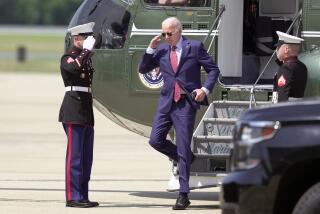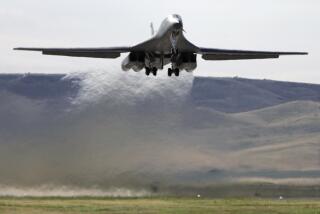U.S. Holds Back B-2 Bombers
WASHINGTON — Defense Secretary William S. Cohen said Wednesday that there is “no need” to use the nation’s most sophisticated new bomber, the B-2 Stealth aircraft, in any campaign against Iraq.
The Air Force has instead deployed older B-52 and B-1B bombers to the Persian Gulf region, a decision that has triggered a sharp debate about the Pentagon’s motives in holding back its most advanced bomber.
Critics charge that the Pentagon is playing an overtly political game, hoping to thwart B-2 supporters in Congress who want to shift funding from other Pentagon programs into building more B-2s. Support for the B-2 could swell if it proved itself in combat.
At the same time, if the B-2 were to perform unsuccessfully in a Persian Gulf deployment, the Air Force would be dealt an indelible black eye: a fleet of bombers costing more than $40 billion impugned by a third-rate power.
But B-2 supporters say the bomber is without question more capable than any other combat jet in the U.S. inventory and that the Pentagon has an obligation to use it.
“This is like Vietnam, letting politics get in the way of what is militarily right,” said Rep. Norman D. Dicks (D-Wash.), long a proponent of buying more B-2s. “I hope there is some other explanation of why they aren’t using the B-2.”
The issue has surfaced just as a high-level military commission, appointed by Congress, is preparing a report for President Clinton on buying more B-2s. The Long Range Air Power Review Panel is expected to complete the report by mid-March.
At the B-2 assembly plant in Palmdale, Northrop Grumman Corp. has not yet mothballed its tools out of continuing hope that it can get a multibillion-dollar order for new bombers. It has failed in that quest since 1993. The program continues to employ 6,200 workers in Los Angeles County.
So far, Pentagon officials have been vague about the decision not to send the B-2 into action, and sources say there is strong sentiment among some senior officials to deploy the jet.
“There’s a lot of unhappiness in the building about the lack of use of the B-2 both because its success would hurt the F-22 [a jet fighter competing for funding] and its failure would be a . . . black eye,” said one senior Defense official. “The B-2 has a definite role, not only in stealth technology but in precision munitions.”
A former Air Force chief of staff, retired Gen. Michael J. Dugan, praised the B-2, saying he “can’t see any reason” why it couldn’t be based in the Gulf.
“It has a long range and good carry capacity--and demonstrated some very accurate use of guided bombs,” Dugan said.
For years, B-2 proponents have argued that the bat-winged bomber would give the U.S. a capability of striking anywhere in the world, even if the Pentagon lacked local operating bases. Now with Saudi Arabia and other Iraqi neighbors hesitating in allowing the Pentagon to use their bases, B-2 advocates are already claiming an intellectual victory.
“If you think you can rely on your allies for bases, you don’t have a very good memory,” said Loren Thompson, a defense expert at the Alexis de Tocqueville Institution, a Washington-area think tank.
The Air Force decision to dispatch older B-1Bs and B-52s to the Gulf was further put into question when another B-1B crashed and exploded in Kentucky on Wednesday. The four crew members parachuted to safety.
Air Force officials said the cause of the crash remains unknown.
It was the second B-1B crash in five months and the sixth since the jet entered service in the early 1990s.
Northrop Grumman has delivered all of the planned 21 B-2 bombers to the Air Force, but only four of the bombers are “Block 30 aircraft”--that is, they have full stealth and weapons capabilities.
If the Air Force were to deploy the fully loaded aircraft, they would have to carry a precision bomb known as the Joint Direct Attack Munition, or JDAM. But there are fewer than 200 JDAMs in the U.S. inventory, not enough for a sustained bombing campaign, according to congressional officials.
(BEGIN TEXT OF INFOBOX / INFOGRAPHIC)
The $2.2-Billion Warplane
Builder: Northrup Grumman Corp.
Assembly time: About three years.
Range: 6,000 miles
Payload capacity: In excess of 40,000 pounds; can deliver conventional and nuclear weapons.
Stealth capabilities: Combination of several factors, including shape and flying style.
More to Read
Sign up for Essential California
The most important California stories and recommendations in your inbox every morning.
You may occasionally receive promotional content from the Los Angeles Times.












